
Cymbopogon, also known as lemongrass, barbed wire grass, silky heads, oily heads, Cochin grass, Malabar grass, citronella grass or fever grass, is a genus of Asian, African, Australian, and tropical island plants in the grass family. Some species are commonly cultivated as culinary and medicinal herbs because of their scent, resembling that of lemons . The name cymbopogon derives from the Greek words kymbe and pogon "which mean [that] in most species, the hairy spikelets project from boat-shaped spathes." Lemongrass and its oil are believed to possess therapeutic properties.

The lesser flamingo is a species of flamingo occurring in sub-Saharan Africa and western India. Birds are occasionally reported from further north, but these are generally considered vagrants.
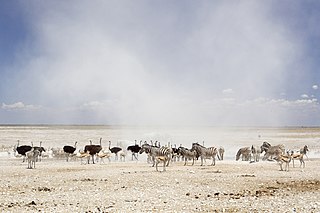
Etosha National Park is a national park in northwestern Namibia and one of the largest national parks in Africa. It was proclaimed a game reserve in March 1907 in Ordinance 88 by the Governor of German South West Africa, Friedrich von Lindequist. It was designated as Wildschutzgebiet in 1958, and was awarded the status of national park in 1967, an act of parliament of the Republic of South Africa. It spans an area of 22,270 km2 (8,600 sq mi) and was named after the large Etosha pan which is almost entirely within the park. With an area of 4,760 km2 (1,840 sq mi), the Etosha pan covers 23% of the total area of the national park. The area is home to hundreds of species of mammals, birds and reptiles, including several threatened and endangered species such as the black rhinoceros. Sixty-one black rhinoceros were killed during poaching in Namibia during 2022, 46 of which were killed in Etosha.
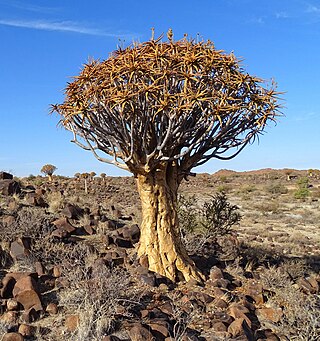
Aloidendron dichotomum, formerly Aloe dichotoma, the quiver tree or kokerboom, is a tall, branching species of succulent plant, indigenous to Southern Africa, specifically in the Northern Cape province of South Africa, and parts of Southern Namibia.

Vachellia tortilis, widely known as Acacia tortilis but now attributed to the genus Vachellia, is the umbrella thorn acacia, also known as umbrella thorn and Israeli babool, a medium to large canopied tree native to most of Africa, primarily to the savanna and Sahel of Africa, but also occurring in the Middle East.
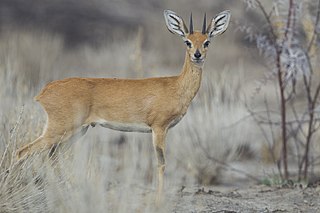
The steenbok is a common small antelope of southern and eastern Africa. It is sometimes known as the steinbuck or steinbok.

Widdringtonia wallichii, Clanwilliam cedar or Clanwilliam cypress, previously Widdringtonia cedarbergensis is a species of Widdringtonia native to South Africa, where it is endemic to the Cederberg Mountains northeast of Cape Town in Western Cape Province. It is threatened by habitat loss and protected in South Africa under the National Forest Act of 1998.
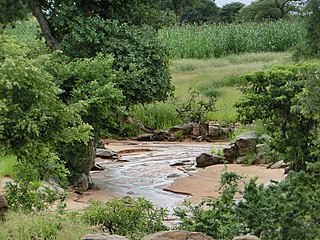
The wildlife of Sudan is composed of its flora and fauna. A variety of climate types in Sudan results in a wide range of habitats and the range of wildlife is diverse. Some 287 species of mammal have been recorded in the country and some 634 species of bird.
Trachyandra erythrorrhiza is a species of plant which is endemic to the province of Gauteng in South Africa. Its natural habitat is intermittent freshwater marshes. It is threatened by habitat loss.

Trachyandra is a genus of plant in the family Asphodelaceae, subfamily Asphodeloideae, first described as a genus in 1843. It is native to eastern and southern Africa, as well as to Yemen and Madagascar. Many of the species are endemic to South Africa.
- Trachyandra acocksiiOberm. - Cape Province in South Africa
- Trachyandra adamsonii(Compton) Oberm. - Cape Province, Namibia
- Trachyandra affinisKunth - Cape Province, KwaZulu-Natal
- Trachyandra arenicolaJ.C.Manning & Goldblatt - Cape Province
- Trachyandra aridimontanaJ.C.Manning - Cape Province
- Trachyandra arvensis(Schinz) Oberm. - Angola, Zambia, Zimbabwe, Botswana, Namibia
- Trachyandra asperataKunth - South Africa, Lesotho, Eswatini
- Trachyandra brachypoda(Baker) Oberm. - Cape Province
- Trachyandra bulbinifolia(Dinter) Oberm. - Cape Province, Namibia
- Trachyandra burkei(Baker) Oberm. - Botswana, Limpopo, Free State, Cape Province
- Trachyandra capillata(Poelln.) Oberm. - KwaZulu-Natal
- Trachyandra chlamydophylla(Baker) Oberm. - Cape Province
- Trachyandra ciliata(L.f.) Kunth - Cape Province, Namibia
- Trachyandra dissectaOberm. - Cape Province
- Trachyandra divaricata(Jacq.) Kunth - Cape Province; naturalized in Australia
- Trachyandra ensifolia (Sölch) Roessler - Namibia
- Trachyandra erythrorrhiza(Conrath) Oberm. - Gauteng
- Trachyandra esterhuysenaeOberm. - Cape Province
- Trachyandra falcata(L.f.) Kunth - Cape Province, Namibia
- Trachyandra filiformis(Aiton) Oberm. - Cape Province
- Trachyandra flexifolia(L.f.) Kunth - Cape Province
- Trachyandra gerrardii(Baker) Oberm. - Eswatini, South Africa
- Trachyandra giffenii(F.M.Leight.) Oberm. - Cape Province
- Trachyandra glandulosa(Dinter) Oberm. - Namibia
- Trachyandra gracilentaOberm. - Cape Province
- Trachyandra hantamensisBoatwr. & J.C.Manning - Cape Province
- Trachyandra hirsuta(Thunb.) Kunth - Cape Province
- Trachyandra hirsutiflora(Adamson) Oberm. - Cape Province
- Trachyandra hispida(L.) Kunth - Cape Province
- Trachyandra involucrata(Baker) Oberm. - Cape Province
- Trachyandra jacquiniana(Schult. & Schult.f.) Oberm. - Cape Province
- Trachyandra kamiesbergensisBoatwr. & J.C.Manning - Cape Province
- Trachyandra karrooicaOberm. - Cape Province, Namibia
- Trachyandra lanata(Dinter) Oberm. - Namibia
- Trachyandra laxa(N.E.Br.) Oberm. - South Africa, Namibia, Botswana
- Trachyandra malosana(Baker) Oberm. - Malawi to Zimbabwe
- Trachyandra mandrarensis(H.Perrier) Marais & Reilly - Madagascar
- Trachyandra margaretaeOberm. - Mpumalanga, KwaZulu-Natal
- Trachyandra montanaJ.C.Manning & Goldblatt - Cape Province
- Trachyandra muricata(L.f.) Kunth - Cape Province, Namibia
- Trachyandra oligotricha(Baker) Oberm. - Cape Province
- Trachyandra paniculataOberm. - Cape Province
- Trachyandra patensOberm. - Cape Province
- Trachyandra peculiaris(Dinter) Oberm. - Namibia
- Trachyandra proliferaP.L.Perry - Cape Province
- Trachyandra pyrenicarpa(Welw. ex Baker) Oberm. Huíla Province in Angola
- Trachyandra revoluta(L.) Kunth - Cape Province, Namibia
- Trachyandra sabulosa(Adamson) Oberm. - Cape Province
- Trachyandra saltii(Baker) Oberm. - eastern + southern Africa from Ethiopia to Cape Province; Yemen
- Trachyandra sanguinorhizaBoatwr. & J.C.Manning - Cape Province
- Trachyandra scabra(L.f.) Kunth - Cape Province
- Trachyandra smallianaHilliard & B.L.Burtt - Cape Province, KwaZulu-Natal
- Trachyandra tabularis(Baker) Oberm. - Cape Province
- Trachyandra thyrsoidea(Baker) Oberm. - Cape Province
- Trachyandra tortilis(Baker) Oberm. - Cape Province
- Trachyandra triquetraThulin - Somalia
- Trachyandra zebrina(Schltr. ex Poelln.) Oberm. - Cape Province
Trachyandra peculiaris is a species of plant which is endemic to Namibia. It is threatened by habitat loss.

The North Saharan steppe and woodlands is a desert ecoregion, in the deserts and xeric shrublands biome, that forms the northern edge of the Sahara. It extends east and west across Northern Africa, south of the Mediterranean dry woodlands and steppe ecoregion of the Maghreb and Cyrenaica, which is part of the Mediterranean forests, woodlands, and scrub biome. Winter rains sustain shrublands and dry woodlands that form an ecotone between the Mediterranean climate regions to the north and the hyper-arid Sahara Desert ecoregion to the south.
Anthene talboti, the Talbot's hairtail or Talbot's ciliate blue, is a butterfly of the family Lycaenidae. It is found from South Africa to Zimbabwe, Kenya, Uganda and Tanzania. In South Africa it is found in the KwaZulu-Natal midlands, through to Orange Free State, Gauteng, Mpumalanga, the Limpopo Province and the North West Province. It is also present in the North Cape.
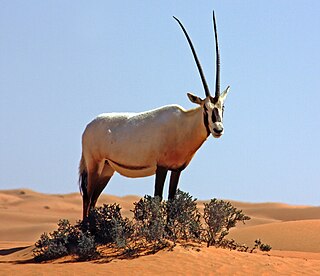
The wildlife of Qatar includes the peninsula's flora and fauna and their natural habitats. The country's terrestrial wildlife includes numerous small nocturnal mammals, a number of reptiles which mainly consist of lizard species, and arthropods. Aquatic animals primarily include fish, shrimp and pearl oysters. The desert and the shoreline form an important resting site for migratory bird species during autumn and spring. Urban and agricultural developments have led to an increase in bird species.
Eucalyptus tortilis is a species of mallet and a gimlet that is endemic to the southwest of Western Australia. It has smooth bark, lance-shaped adult leaves, flower buds in groups of seven, creamy white flowers and hemispherical to cup-shaped fruit.
"Onion weed" may refer to several species of plant that are either related to onions, have onion-like bulbs or flowers, or smell oniony or garlicky, and that are considered weeds outside their native ranges. These include:
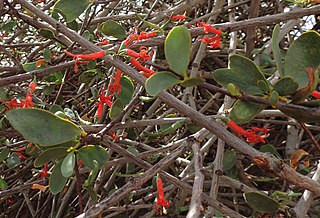
Plicosepalus acaciae, the acacia strap flower, is a species of hemiparasitic flowering plant in the family Loranthaceae. It is native to northeastern Africa, the Levant, and the Arabian Peninsula. As its common and scientific names suggest, it parasitizes acacias; Vachellia tortilis subsp. raddiana and V. t. subsp. tortilis. It seeds are dispersed by the white-spectacled bulbul.

Limeum africanum is a species of flowering plant in the genus Limeum. It is endemic to Southern Africa. It is also known by the names common lizardfoot and koggelmandervoet; Afrikaans for the foot of a lizard from the genus Agama.

Lapeirousia pyramidalis is a species of geophyte in the genus Lapeirousia. It is endemic to the Cape Provinces of South Africa. It is also known as the pyramid kabong.















